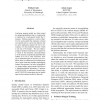44 search results - page 3 / 9 » Predictive automatic relevance determination by expectation ... |
IEAAIE
2010
Springer
13 years 2 months ago
2010
Springer
It is desirable to ensure that the thermal comfort conditions in offices are in line with the preferences of occupants. Controlling their offices correctly therefore requires the c...
RTCSA
1999
IEEE
13 years 9 months ago
1999
IEEE
This paper presents a method for tight prediction of worst-case performance of data caches in highperformance real-time systems. Our approach is to distinguish between data struct...
BMCBI
2010
13 years 5 months ago
2010
Background: Determining beforehand specific positions to align (anchor points) has proved valuable for the accuracy of automated multiple sequence alignment (MSA) software. This f...
ICMCS
2010
IEEE
13 years 6 months ago
2010
IEEE
Mood annotation of music is challenging as it concerns not only audio content but also extra-musical information. It is a representative research topic about how to traverse the w...
EMNLP
2011
12 years 4 months ago
2011
Log-linear parsing models are often trained by optimizing likelihood, but we would prefer to optimise for a task-specific metric like Fmeasure. Softmax-margin is a convex objecti...

